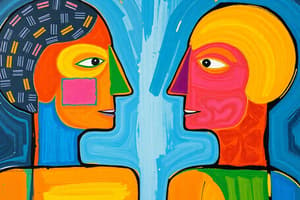Podcast
Questions and Answers
What is social loafing?
What is social loafing?
Which concept explains why people comply with orders?
Which concept explains why people comply with orders?
What does the bystander effect refer to?
What does the bystander effect refer to?
Which principle suggests that frustration can lead to aggression?
Which principle suggests that frustration can lead to aggression?
Signup and view all the answers
What is groupthink?
What is groupthink?
Signup and view all the answers
What describes the concept of superordinate goals?
What describes the concept of superordinate goals?
Signup and view all the answers
What is the primary reason for cognitive dissonance?
What is the primary reason for cognitive dissonance?
Signup and view all the answers
In a tight culture, how are societal norms generally characterized?
In a tight culture, how are societal norms generally characterized?
Signup and view all the answers
What is dispositional attribution?
What is dispositional attribution?
Signup and view all the answers
What defines the actor-observer bias?
What defines the actor-observer bias?
Signup and view all the answers
What is the concept behind cognitive dissonance?
What is the concept behind cognitive dissonance?
Signup and view all the answers
How does the mere exposure effect influence people's feelings?
How does the mere exposure effect influence people's feelings?
Signup and view all the answers
What is the main idea behind the foot in the door phenomenon?
What is the main idea behind the foot in the door phenomenon?
Signup and view all the answers
What distinguishes explicit prejudice from implicit prejudice?
What distinguishes explicit prejudice from implicit prejudice?
Signup and view all the answers
What does the just world phenomenon imply?
What does the just world phenomenon imply?
Signup and view all the answers
What does groupthink refer to in a social context?
What does groupthink refer to in a social context?
Signup and view all the answers
Study Notes
Person Perception
- Attribution Theory: Explains why people behave the way they do.
- Dispositional Attribution: Explains behavior based on personality.
- Situational Attribution: Explains behavior based on the situation.
- Actor-Observer Bias: When explaining our own actions, we attribute them to the situation. When explaining others' actions, we attribute them to their personality.
- Fundamental Attribution Error: Overestimating internal factors and underestimating external factors in explaining others' behavior.
- Mere Exposure Effect: Repeated exposure to something increases liking.
- Proximity, Attraction, Similarity: Factors influencing attraction.
- Attitudes: Feelings influenced by beliefs, leading to specific responses.
- Foot-in-the-Door Phenomenon: Agreeing to a small request makes it more likely to agree to a larger request.
- Roles: Societal norms regarding specific positions.
- Cognitive Dissonance Theory: Adjusting thoughts to match actions to reduce discomfort.
- Persuasion: Changing attitudes.
- Peripheral Route Persuasion: Influenced by superficial cues (e.g., attractiveness).
- Central Route Persuasion: Influenced by logic and evidence.
- Prejudice: Unjustified negative attitude toward a group.
- Implicit Prejudice: Unintentional bias.
- Explicit Prejudice: Intentional bias.
- Stereotyping: Generalized belief about a group.
- Discrimination: Unjustified negative behavior toward a group.
- Just-World Phenomenon: Belief the world is fair, blaming victims for their circumstances.
- Social Identity: Defining ourselves based on groups.
- Ingroup: Groups we belong to.
- Ingroup Bias: Favoring our own group.
- Outgroup: Groups we don't belong to.
- Vivid Case: An impactful example influencing judgments.
- Scapegoat Theory: Blaming others for problems.
- Other-Race Effect: Easier recognition of faces of one's own race.
- Conformity: Adjusting behavior to fit in.
- Normative Social Influence: Conformity to gain acceptance.
- Informational Social Influence: Conformity based on belief in others' knowledge.
- Social Contagion: Mimicking behaviors of others.
- Obedience: Complying with orders.
- Social Facilitation: Improved performance on simple tasks in the presence of others.
- Social Loafing: Reduced effort in group tasks.
- Deindividuation: Loss of self-awareness in group settings, leading to impulsive acts
- Group Polarization: Group decisions becoming more extreme after discussion.
Culture & Altruism
- Culture: Shared behaviors and ideas within a group.
- Tight Culture: Strict norms.
- Loose Culture: Flexible norms.
- Altruism: Selfless concern for others' well-being.
- Bystander Effect: Less likely to help when others are present.
- Social Exchange Theory: Relationships based on cost-benefit analysis.
- Reciprocity Norm: Expectation of helping those who have helped us.
- Social Responsibility Norm: Expectation of helping those in need.
- Conflict: Incompatible goals.
- Social Trap: Individual self-interest leading to collective harm.
- Mirror-Image Perceptions: Seeing ourselves as good and others as bad.
- Self-Fulfilling Prophecy: Expectations influencing outcomes.
- Superordinate Goals: Shared goals uniting people.
- Frustration-Aggression Principle: Frustration leading to aggression.
- Social Script: Learned behaviors in specific situations.
Specific Concepts:
- Leon Festinger: Cognitive dissonance and social comparison
- Solomon Asch: Conformity
- Stanley Milgram: Obedience
- John Darley / Bibb Latané: Bystander effect
- Attribution Theory
- Groupthink: Maintaining group consensus despite disagreement
- Culture: Behaviors, ideas, traditions across generations
- Bystander effect: Less likelihood of help with more onlookers
- Social exchange: Cost-benefit relationship analysis in social interactions
- Social responsibility norm: societal obligation to assist others in need
Studying That Suits You
Use AI to generate personalized quizzes and flashcards to suit your learning preferences.
Related Documents
Description
Test your knowledge on the concepts of person perception in psychology. This quiz covers attribution theory, biases in behavior explanation, and factors influencing attraction and attitudes. Dive deep into psychological principles and see how they apply to real-life situations.




